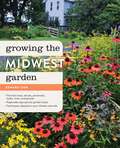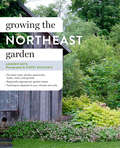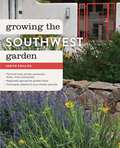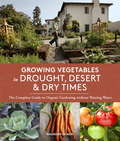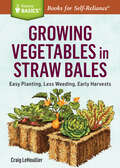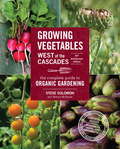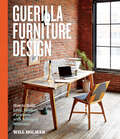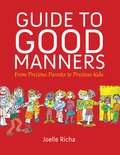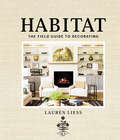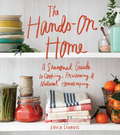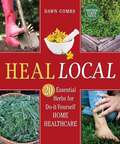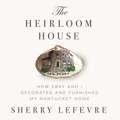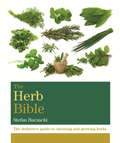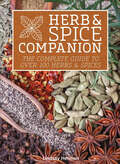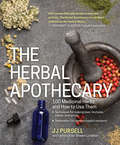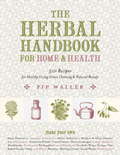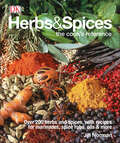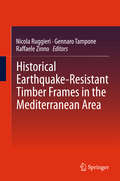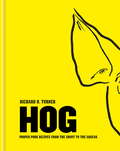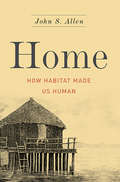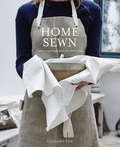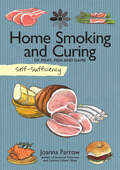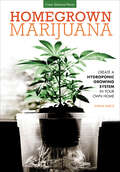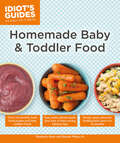- Table View
- List View
Growing the Midwest Garden: Regional Ornamental Gardening (Regional Ornamental Gardening Series)
by Edward LyonPart of the Timber Press Regional Ornamental Gardening book series, this book is ideal for home gardeners in Illinois, Indiana, Iowa, Kansas, Michigan, Minnesota, Missouri, Nebraska, North Dakota, Ohio, South Dakota, Wisconsin, southern Ontario, southern Manitoba, and southeastern Saskatchewan.
Growing the Northeast Garden: Regional Ornamental Gardening (Regional Ornamental Gardening Series)
by Andrew Keys Kerry MichaelsPlant selection and garden style are deeply influenced by where we are gardening. To successfully grow a range of beautiful ornamental plants, every gardener has to know the specifics of the region’s climate, soil, and geography. Gardeners in the northeast are lucky—the regular summer rain, gorgeous summer blooms, and stunning fall color make it an ideal place to garden. But there are drawbacks, like hot and humid summers, bitterly cold winters, and mosquitos. TThe practical and beautiful Growing the Northeast Garden starts with a comprehensive overview of the weather and geography of the area, along with regionally specific advice on zones, microclimates, soil, pests, and maintenance. Profiles of the best trees, shrubs, perennials, annuals, and bulbs offer hundreds of plant suggestions, along with complete information on growth and care.
Growing the Southwest Garden: Regional Ornamental Gardening (Regional Ornamental Gardening Series)
by Judith PhillipsPlant selection and garden style are deeply influenced by where we are gardening. To successfully grow a range of beautiful ornamental plants, every gardener has to know the specifics of the region’s climate, soil, and geography.Growing the Southwest Garden, by New Mexico-based garden designer Judith Phillips, is a practical and beautiful handbook for ornamental gardening in a region known for its low rainfall and high temperatures. With more than thirty years of experience gardening in the Southwest, Phillips has created an essential guide, featuring regionally specific advice on zones, microclimates, soil, pests, and maintenance. Profiles of the best plants for the region include complete information on growth and care.
Growing Vegetables in Drought, Desert & Dry Times
by Maureen GilmerHere is the definitive guide to growing healthy organic vegetables without wasting our precious water resources! This incredibly timely book will give dedicated home gardeners the know-how to grow delicious produce in dry times, focusing on four different low-water conditions in the western United States: voluntary water conservation, drought, and both high and low desert. Using modern techniques, as well as tips and stories from native traditions ranging from the southwestern United States to the Middle East, this guide offers the best of ancient wisdom and the newest innovations in conservation, and includes varietal recommendations and a seasonal crop guide.From the Trade Paperback edition.
Growing Vegetables in Straw Bales: Easy Planting, Less Weeding, Early Harvests. A Storey BASICS® Title (Storey Basics)
by Craig LeHoullierStraw bale gardening is an inexpensive, low-maintenance way to grow a bounty of food in a small space. All you need is a bale of straw, some fertilizer, and your favorite vegetable seeds! Craig LeHoullier’s step-by-step instructions show you how to do everything from sourcing the straw and setting up your bale to planting, dealing with weeds and pests, and harvesting.
Growing Vegetables West of the Cascades, 35th Anniversary Edition
by Steve Solomon Marina McshaneCompletely revised from cover to cover, this is the 35th anniversary release of Growing Vegetables West of the Cascades, the bible to organic vegetable gardening in the Pacific Northwest. Now in its seventh edition, the book has been thoroughly updated and includes a new formula for complete organic fertilizer and how to tweak it for a variety of different soil conditions, how-to sections for herbs and ornamental plants, new organization for better usability, updated sources for appropriate seed suppliers, and information about natural pest controls.From the Trade Paperback edition.
Guerilla Furniture Design: How to Build Lean, Modern Furniture with Salvaged Materials
by Will HolmanBuild stylish and functional furniture from salvaged materials. This innovative guide presents dozens of strategies for upcycling scrap cardboard, metal, plastic, or wood into dependable shelving units, sturdy tables, and fun lamps. With directions for 35 easy and inexpensive projects that include a Cardboard Cantilever Chair, a License Plate Bowl, a Conduit Coatrack, and much more, you’ll be inspired to start filling your home with unique high-style furniture that makes sense for both your wallet and the environment.
Guide to Good Manners: From Precious Parents to Precious Kids
by Joelle RichaLovingly written and illustrated, Guide to Good Manners provides families with an opportunity to learn about manners in a fun, engaging way. From table etiquette to proper behavior at school and with friends, Guide to Good Manners covers everything children need to know to become courteous and caring individuals.Guide to Good Manners includes:• Manners for home, school, and public places• Etiquette at the dinner table• Proper hygiene• Safety tips and safe street behavior• Online and computer etiquetteFrom the Trade Paperback edition.
Habitat: The Field Guide to Decorating
by Lauren LiessLauren Liess, an interior designer and founder of the popular blog Pure Style Home, fuses her love of design and the great outdoors into all her work. In Habitat: The Field Guide to Decorating, her first book, Lauren invites readers to bring nature inside by mixing the textures of natural elements such as wood and stone with eclectic groupings of modern and quirky vintage pieces. Readers will be inspired by the unique style of these rooms, which include lovely framed botanical prints and Liess’s own textile patterns inspired by wildflowers and weeds. The book is divided into three sections: Part I focuses on the fundamental elements of design, with each chapter devoted to a particular element, such as color, lighting, and furniture; Part II addresses the intangibles of designing a space, such as aesthetics and creating a mood; and Part III tackles unique room-specific challenges in every part of the house.
The Hands-On Home
by Erica Strauss Charity BurggraafWant to create an organized, productive, and beautiful kitchen and home? Popular Seattle blogger, Erica Strauss (Northwest Edible Life) shows us how in this modern homekeeping handbook for thrifty DIYers who care about sustainability. A fresh take on modern homemaking, this is a practical (and sometimes sassy) guide to maximizing your time, effort, and energy in the kitchen and beyond. With a focus on less consumerism, it will teach you how to organize your kitchen and home to make the best use of your time. For those yearning to live a more ecologically minded, grounded lifestyle, this book is full of practical, no-nonsense advice, fabulous recipes, and time- and money-saving techniques.From the Hardcover edition.
Heal Local: 20 Essential Herbs for Do-it-Yourself Home Healthcare (Mother Earth News Books for Wiser Living)
by Dawn CombsMost of us understand the value of eating and buying local. Taking back our food, goods, and services from multinational corporations and sourcing them from small growers, producers, artisans, and entrepreneurs benefits our families, our environment, and our communities. Heal Local argues that "100-mile healthcare" can be equally valuable in terms of how we treat illness and injury and maintain wellness.This innovative guide demonstrates that by harnessing multifaceted whole plants, we can rely on homegrown or regionally produced herbs rather than importing exotics and non-natives. Based on the small apothecary model, author Dawn Combs explains how to: *Maximize the benefits of homegrown first aid, from increased freshness, potency, and effectiveness to community resilience and local economic growth *Make home herbal healthcare less intimidating and more attainable, by focusing on twenty herbs to effectively treat most common injuries and ailments*Implement a local medicine culture safely and sustainably, while protecting and respecting wild plant populationsMany herbals overwhelm their readers, presenting a list of hundreds of herbs, each with a different purpose. Heal Local empowers readers by showing that you don't need to know everything about every herb on the planet to create a complete home apothecary. Anyone can be self-sufficient with their wellness, regardless of their previous knowledge, experience, or available space.Dawn Combs is a homestead herbalist with over twenty years' experience and author of Conceiving Healthy Babies. As well as training others in herbal home healthcare, she treats her family's common illnesses and minor injuries with natural therapies, herbal remedies, and appropriate foods.
Heirloom House: How eBay and I Decorated and Furnished My Nantucket Home
by Sherry LefevreInspiration for Every Home Decorator with a Passion for the Past The Heirloom House is a humorous personal account of two interlocking obsessions: eBay and the quest to create a vacation house that looks and feels like a family heirloom. Beginning with recollections of her childhood summers in Nantucket, author Sherry Lefevre narrates the development of her personal aesthetic: wanting everything people with old inherited houses have. When she receives a bequest that allows her to purchase her own ramshackle summerhouse, she clicks on eBay and emerges two months later with a house fully furnished with other people’s ancestral treasures, from toile curtains to taxidermy, at a more-than-affordable price. Filled with photos and drawings, The Heirloom House invites readers to follow Lefevre’s eBay searches and imitate her heirloom-hunting strategies. Antique treasures are classified and eBay "search words” are suggested to assist the reader’s own treasure hunting. Anecdotes, both informative and entertaining, enliven descriptions of the antique objects acquired, and while the whole endeavor is relayed with humor, the underlying message is a serious one: with enough love, anyone can have an ancestral home--an heirloom house.
The Herb Bible: The Definitive Guide To Choosing And Growing Herbs
by Stefan BuczackiDiscover more than 130 herbs in this authoritative and attractive reference book by horticultural expert Stefan Buczacki. There is at-a-glance information on a wide range of herbs with advice on how to grow them and their best uses - both culinary and ornamental. Designing and planning a herb garden is also considered, with advice on site, soil and style.
The Herb Bible: The definitive guide to choosing and growing herbs
by Dr Stefan BuczackiDiscover more than 130 herbs in this authoritative and attractive reference book by horticultural expert Stefan Buczacki. There is at-a-glance information on a wide range of herbs with advice on how to grow them and their best uses - both culinary and ornamental. Designing and planning a herb garden is also considered, with advice on site, soil and style.
Herb & Spice Companion: The Complete Guide to Over 100 Herbs & Spices
by Lindsay HermanYou can spice up your cooking when you learn how to grow, dry, store and use over 100 herbs and spices—from angelica to woodruff, allspice to vanilla.Herb and Spice Companion is your ultimate guide for using fresh and dried herbs and spices in the kitchen. Inside this handy book, get descriptions of more than 100 herbs and spices from around the world. Discover useful tips on storing and using spices to create innovative combinations of flavors. This is the essential guidebook to using herbs and spices to add flavor and depth in your cooking. From basil to beebalm, from lavender to lemon verbena, learn all of the interesting aspects of your herbs, including their rich history, how to grow, harvest, and dry them, and even their unique medicinal uses. This is a must-have for anyone’s cookbook library.
The Herbal Apothecary: 100 Medicinal Herbs and How to Use Them
by Jj Pursell“A brilliant addition to any library.” —Rosemary Gladstar, herbalist and bestselling author More and more people are exploring the healing possibilities of plant-based medicines, and health shops across the country now stock their shelves with natural remedies, but treatments can easily be made at home. The Herbal Apothecary profiles 100 of the most important medicinal plants with striking photographs and step-by-step instructions for making herbal teas, tinctures, compresses, and salves to treat everything from muscle strain to the common cold or anxiety. This holistic guide also includes advice for the home gardener on growing and foraging for medicinal plants. Incorporating traditional wisdom and scientific information, The Herbal Apothecary provides an accessible and comprehensive introduction to plant-based medicine. With the guidance of naturopath JJ Pursell, herb enthusiasts can learn how to safely create their own remedies using plants they know and love.
The Herbal Handbook for Home and Health
by Pip WallerKitchen pharmacy meets green cleaning and natural beauty in this comprehensive handbook of 501 recipes that harness the power of plants to enhance wellness and toxin-free living. Expert herbalist Pip Waller provides a wealth of information about growing, collecting, preserving, and preparing herbs for a variety of purposes--from cleaning products, to food and drink, medicines, beauty products, and more. Attractive and easy to use, The Herbal Handbook for Home and Health includes growing tips and profiles of herbs, guidelines for setting up an herbalist's kitchen, and techniques to make everything from tinctures to tonics. A valuable resource for anyone affected by allergies or sensitivities, this compendium is handsomely produced with two-color printing throughout and more than three hundred striking illustrations.The Handbook includes contributions from herbalists from around the world and encompasses recipes that range from very simple to more complex. Seasoned herbalists as well as those just beginning to explore the world of herbs will find something to start their own nontoxic, non-allergenic domestic revolution.The book includes: * A history of herbal lore * The herbalist's kitchen--equipment and procedures for harnessing the power of plants * Green cleaning products (from floor wax to stain removers) * Herbal pharmacy (from throat lozenges to hangover cures) * Nutritional supplements and detoxes * First aid (from anti-anxiety drops to bruise ointment) * For travel (insect repellant to anti-nausea drops) * Food and drink (breads, butters, wines, teas) * Beauty and balms (toothpaste to shampoo to lip balm) * Kitchen Pharmacy * Food & Drink * Beauty, Balms & Personal Care
Herbs & Spices: Over 200 Herbs and Spices, with Recipes for Marinades, Spice Rubs, Oils, and Mor
by Jill NormanThe first illustrated guide to cover the whole spectrum of herbs and spices for culinary use. Herbs & Spices is an indispensable reference that shows how to prepare fresh and dried herbs, how to use herbs and spices in cooking, and details everything that other books on the subject leave out. Containing a unique collection of recipes, from herb and spice mixes to rubs, pastes, salsas, and marinades, these authentic formulas will encourage cooks to think creatively and experiment on their own. Grouped by aroma and taste, with step-by-step preparation techniques and beautiful full-color photography, this book describes 60 herbs and the benefits of using them fresh or dried, and focuses on 60 spices from around the world, with a look at the early spice trade and how cross-cultural fusion has impacted on contemporary cooking.
Historical Earthquake-Resistant Timber Frames in the Mediterranean Area
by Nicola Ruggieri Gennaro Tampone Raffaele ZinnoThis book presents a selection of the best papers from the HEaRT 2013 conference, held in Cosenza, Italy, which provided a valuable forum for engineers and architects, researchers and educators to exchange views and findings concerning the technological history, construction features and seismic behavior of historical timber-framed walls in the Mediterranean countries. The topics covered are wide ranging and include historical aspects and examples of the use of timber-framed construction systems in response to earthquakes, such as the gaiola system in Portugal and the Bourbon system in southern Italy; interpretation of the response of timber-framed walls to seismic actions based on calculations and experimental tests; assessment of the effectiveness of repair and strengthening techniques, e. g. , using aramid fiber wires or sheets; and modelling analyses. In addition, on the basis of case studies, a methodology is presented that is applicable to diagnosis, strengthening and improvement of seismic performance and is compatible with modern theoretical principles and conservation criteria. It is hoped that, by contributing to the knowledge of this construction technique, the book will help to promote conservation of this important component of Europe's architectural heritage.
Hog: Proper pork recipes from the snout to the squeak
by Richard H. Turner'If you're after advice on what to do with any cut you can think of, look no further.'The Caterer 'Hog is a bible for pork fans everywhere...the book celebrates the versatility, appeal and - most importantly - the taste of the pig.'Great British FoodHog is a celebration of all things pig - from breeds and rearing, to butchering and preparing, with techniques, features and more than 150 recipes for nose to tail eating. The comprehensive range of dishes includes hams, bacon, sausages, charcuterie, pates, confits, roasts, grills, hotpots, ragouts, pies, casseroles, scratchings, crackling, trotters and much more - with a foreword from Josh Ozersky and guest contributions from a range of British, American and International chefs and cooks including Diana Henry, Meredith Erickson, Judy Joo, Valentine Warner, Neil Rankin, Mitch Tonks, Fergus Henderson and Aaron Franklin.
Home: How Habitat Made Us Human
by John S. AllenHome is where the heart is. Security, comfort, even love, are all feelings that are centered on the humble abode. But what if there is more to the feeling of being at home? Neuroanthropologist John S. Allen believes that the human habitat is one of the most important products of human cognitive, technological, and cultural evolution over the past two million years. In Home, Allen argues that to "feel at home" is more than just an expression, but reflects a deep-seated cognitive basis for the human desire to have, use, and enjoy a place of one's own. Allen addresses the very basic question: How did a place to sleep become a home? Within human evolution, he ranks house and home as a signature development of our species, as it emerged alongside cooperative hunting, language, and other critical aspects of humanity. Many animals burrow, making permanent home bases, but primates, generally speaking, do not: most wander, making nests at night wherever they might find themselves. This is often in home territory, but it isn't quite home. Our hominid ancestors were wanderers, too--so how did we, over the past several million years, find our way home? To tell that story Allen will take us through evolutionary anthropology, neuroscience, the study of emotion, and modern sociology. He examines the home from the inside (of our heads) out: homes are built with our brains as much as with our hands and tools. Allen argues that the thing that may have been most critical in our evolution is not the physical aspect of a home, but developing a feeling of defining, creating, and being in a home, whatever its physical form. The result was an environment, relatively secure against whatever horrors lurked outside, that enabled the expensive but creative human mind to reach its full flowering. Today, with the threat of homelessness, child foster-care, and foreclosure, this idea of having a home is more powerful than ever. In a clear and accessible writing style, Allen sheds light on the deep, cognitive sources of the pleasures of having a home, the evolution of those behaviors, and why the deep reasons why they matter. Home is the story about how humans evolved to create a space not only for shelter, but also for nurturing creativity, innovation, and culture--and why "feeling at home" is a fundamental aspect of the human condition.
Home Sewn: Projects and Inspiration for Every Room
by Cassandra EllisTransform your home with fabric as your foundation This beautiful craft book features distinctive sewing projects dedicated to living, resting, eating, and sharing. Use quality materials--from rustic linen to leather--to create simple ottomans, pendant light shades, a voile bed skirt, and more. With dreamy lifestyle photography and ideas for every room, Home Sewn is a keepsake for the modern maker.
Home Smoking and Curing of Meat, Fish and Game: Of Meat, Fish And Game (Self-Sufficiency #7)
by Joanna FarrowMake the tastiest bacon, most delicious smoked fish, or perfectly cured salami without the need for high-tech equipment or expensive ingredients.Smoking and curing originated as ways to preserve food before the advent of tin cans, freezers and vacuum packs. Nowadays, these ancient skills are enjoying a comeback as many of us look towards a more self-sufficient and rewarding way of preparing, storing and eating our food. In this book, author Joanna Farrow explains how with some basic ingredients and equipment, you can soon be salting, curing, air-drying, and smoking a whole range of seasonal and year-round produce. With clear instructions and advice to help you get started, plus twenty-five original recipes for meat, game, and shellfish, this book will give you the confidence and know-how to begin your own experiments. What could be more delicious than home-cured bacon, subtle smoked salmon, or air-dried ham? With guides to setting up your own smoker, preparing salt and brine cures, drying, and preserving, Self-Sufficiency: Home Smoking and Curing is the perfect introduction to making the most of meat, fish, game and poultry.
Homegrown Marijuana: Create a Hydroponic Growing System in Your Own Home
by Joshua SheetsA gardener’s guide to growing marijuana plants. If growing Cannabis is permitted where you live, a hydroponic system is your homegrown solution.With marijuana laws changing rapidly, millions of gardeners with an interest in growing Cannabis can finally step out of their curtained basements and raise this unique and ancient plant without worry and in plain view.As with any other plant we grow, you’ll find a wide range of strategies for growing marijuana. The variables between approaches are many, including success rates, security, and cost. Indoor, water-based hydroponic systems are the best option for just about any homeowner: they are clean, reliable, highly productive, and can be built for minimal cost. In Homegrown Marijuana, you’ll find all the information you need to create and operate a hydroponic growing system in your own home.This book is intended for people who live in areas that have legalized growing marijuana, for medical use or otherwise, and who wish to produce it for their own consumption. Using step-by-step instructions and photos, hydroponics and marijuana-growing expert Joshua Sheets explains how to create, build, maintain, and harvest a marijuana garden. He also includes plenty of background information you’ll want to know on subjects such as nutrient solutions, propagating plants, selecting varieties, troubleshooting problems, and much more. You’ll see that a hydroponic marijuana garden is not so different from other gardens you’ve grown—except, of course, that in this garden, the weed is encouraged.
Homemade Baby & Toddler Food (Idiot's Guides)
by Kimberly Aime Natalie WeissMake the best food for your baby and toddler from home!Store-bought baby food is expensive and can contain artificial ingredients you don't want your baby to consume. And as a baby grows to be a toddler, it can be difficult to find nutritious and easy-to-fix foods that they will eat. Idiot's Guides: Homemade Baby & Toddler Food comes to the rescue with the solution to feeding dilemmas for parents of babies and toddlers from 6 to 24 months: • 100 recipes for appealing baby and toddler cuisine, from purees to finger foods to table foods even the pickiest toddlers will eat. • More than 100 full-color photos of finished dishes, preparation steps, and more. • Nutrition and development information, plus meal plans for five different stages from a registered dietitian. • Advice for encouraging picky eaters to try new things. Illustrated how-to steps for frequently used techniques. • Information on baby-led weaning, food allergies, and other high-interest topics.
